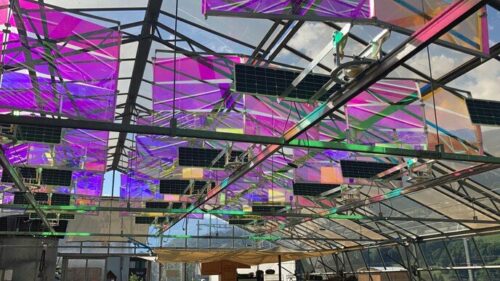The unused sunlight waves by the plants can be concentrated on photovoltaic cells to generate electricity.
Plants use only a fraction of light spectrum for photosynthesis. What if we could utilize the rest of the light spectrum from sunlight to generate solar power. This is the idea behind the development of solar modules developed by EPFL startup Voltiris.

Greenhouses are highly used in areas that cannot grow light and heat intensive like tomatoes, cucumbers peppers etc. “It costs more than CHF 1.5 million a year to heat a 5-hectare greenhouse,” says Nicolas Weber, the CEO of Voltiris. “And a greenhouse of that size emits roughly the same amount of CO2 per year as 2,000 people.”
Plants are selective about which parts of the spectrum they use, relying on red and blue light. The system developed by Voltiris concentrates the remaining unused waves from sunlight onto photovoltaic (PV) cells. The filters of the system let these wavelengths pass through, while directing the other wavelengths (green and near-infrared) towards PV cells where they’re converted into solar power. The system is designed to track the position of sunlight.
Two patented inventions make Voltiris’ system unique and able to perform so well. The first is an optimized optical system that effectively concentrates sunlight, and the second is a solar-tracking device designed for under-roof use, which extends the length of time the system can produce solar power by 40%. The system consists of dichroic mirrors, which show a different coloration, depending on the observation condition.
“We plan to apply different treatments to the reflective glass based on the needs of specific crops, in order to improve our yields even further,” says Weber. The tests show that it should be able to cut the greenhouses’ CO2 emissions in half while providing between 60% and 100% of their energy needs depending on the heating system in place: “emissions are not reduced to zero because our system will start to replace electricity, which is generally “cleaner” than gas. “This translates into an environmental benefit but also a financial one,” says Weber.





